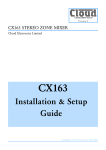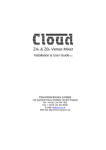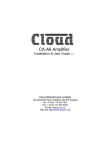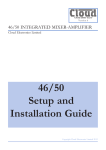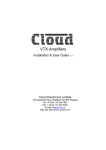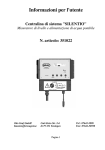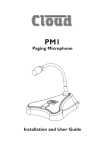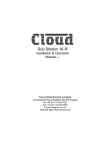Download Cloud CX133 User guide
Transcript
CX133 Zone Mixer Installation & User Guide V9.0 Cloud Electronics Limited 140 Staniforth Road, Sheffield, S9 3HF England Tel + 44 (0) 114 244 7051 Fax + 44 (0) 114 242 5462 E-mail [email protected] Web site http://www.cloud.co.uk 1 CX133: INSTALLATION AND OPERATION MANUAL CX133 ZONE MIXER Installation and operation manual Contents Section Page 1 Safety Notes...............................................................................2 2 General Description ...................................................................2 3 Schematic Diagram ....................................................................2 4 Music Inputs ...............................................................................2 4.1 Sensitivity & Gain Control.....................................................2 4.2 Music Source Select.............................................................3 4.3 Music Level Control, Local or Remote..................................3 5 Mono Operation .........................................................................4 6 Music Priority..............................................................................4 7 Microphone Input .......................................................................5 7.01 Microphone Input ...............................................................5 7.02 Gain Control .......................................................................5 8 Front Panel Level Controls.........................................................5 9 Microphone Equalisation ............................................................5 10 Microphone Priority ....................................................................5 11 Inhibiting Mic or Music Sections .................................................5 12 Zone outputs ..............................................................................6 12.1 Music Equalisation .............................................................6 13 Utility Output...............................................................................6 14 Music Mute (Fire Alarm Interface) ..............................................7 15 General Notes ............................................................................7 15.1 Multi-zone Applications ......................................................7 15.2 EMC Considerations ..........................................................7 15.3 Earthing..............................................................................7 15.4 Unbalanced Mode ..............................................................8 29/05/02 V9 16 Technical Specifications.............................................................8 17 General Specifications ...............................................................8 2 1 CX133: INSTALLATION AND OPERATION MANUAL Safety Notes • • • • • Do not expose the unit to water or moisture Do not expose the unit to naked flames. Do not block or restrict any air vent Do not operate the unit in ambient temperatures above 35oC Do not perform any internal adjustments unless you are qualified to do so and fully understand the hazards associated with mains operated equipment. • The unit has no user serviceable parts. Refer any servicing to qualified service personnel. • If the moulded plug is cut off the lead for any reason, the discarded plug is a potential hazard and should be disposed of in a responsible manner. For more detailed information refer to the rear of the manual. 2 General Description The Cloud CX133 is versatile audio mixer with applications in Licensed, Retail and Leisure venues. The unit has facilities for three stereo line signals and one microphone signal that can be fed, in stereo, to two areas, each with a front panel mounted music source select switch and adjacent music level and microphone level controls. In addition, a fixed level ‘Utility’ output is provided to serve general utility areas such as toilets and foyers etc. All preset controls are located on the rear panel with additional configuration jumpers mounted on the printed circuit board. Remote level controls can be wired to the two stereo zones for applications that require remote control of the music level. 3 Schematic diagram 4 Music Inputs The unit has three stereo line inputs; these are suitable for most music sources such as compact disc players, tape players, satellite receivers and the like. All inputs are unbalanced and use RCA phono sockets. The input impedance is 47k ohms. The Line 3 input can be configured to have priority over any other music source, see section 6. 4.1 Sensitivity & Gain Control All three stereo line inputs have a pre-set gain control on the rear panel adjacent to the respective input socket. The gain control has a range of 20dB allowing the input sensitivity to be varied from -12dBu (200mV) to +8dBu (2.0V). The pre-set gain control should be set so that all the input signals are operating at the same level and that the front panel level control has an optimum range of control. 29/05/02 V9 3 CX133: INSTALLATION AND OPERATION MANUAL 4.2 Music Source Select Each zone has an independent source select control. The three position switch is used to select the desired music signal. Use the supplied label pack to identify the signal sources on the front panel. Line 3 input can be configured to have priority over any other selected signal, see section 6 for full details. The Utility output can operate with the Zone 1 music programme, Line 1 input or just the microphone; see section 13 for full details. 4.3 Music Level Control, Local or Remote A front panel mounted music level control is provided for each of the two main zones. Remote control of the Zone 1 and Zone 2 music level is possible by connecting a remote level control plate (RL-1) to the 4 pole connector on the rear panel of the CX133 (see connection diagram Figure 1 below). Either or both of the two main zones can operate in the ‘split’ mode where two remote level plates can be wired to control the left and right outputs independently. When operating in the ‘split’ mode, the respective zone of the CX133 should be configured to operate in the mono mode (see section 5 'Mono Operation'). The front panel level control can be defeated by configuring the relevant internal jumpers, see Figure 3 for full details. Use two core screened cable to connect the remote level plate (maximum length 100metres). Full wiring details are also printed on the underside of the CX133. Figure 1 REMOTE LEVEL CONTROL WIRING CX133 4 POLE RL-1 CONNECTOR 1 1 2 2 3 4 3 STANDARD WIRING CONVENTION FOR APPLICATIONS WITH ONE RL-1 FOR EACH ZONE USE TWO CORE SCREENED CABLE Figure 2 LEFT OUTPUT SPLIT MODE LEVEL CONTROL CX133 4 POLE CONNECTOR RL-1 1 1 2 RIGHT OUTPUT LEVEL CONTROL 2 3 RL-1 4 3 1 2 3 REMOTE LEVEL CONTROL WIRING - USE TWO CORE SCREENED CABLE SPLIT MODE - WITH INDEPENDANT CONTROL OF LEFT AND RIGHT OUTPUTS EACH ZONE CAN BE SPLIT INTO TWO SUB ZONES THE RESPECTIVE ZONE SHOULD BE CONFIGURED TO OPERATE IN MONO WHEN THIS FACILITY IS UTILISED 29/05/02 V9 4 CX133: INSTALLATION AND OPERATION MANUAL Figure 3 5 Mono Operation MONO / STEREO OPERATION Internal jumpers allow either zone to operate in mono (see Figure 4). In the mono mode of operation, both the left and right output sockets carry the same mono signal and either or both sockets can be used. Separate remote control of the mono signal on the left and right output socket can be achieved by wiring two RL-1 control plates to the 4 pin connector as shown in Figure 2 When this feature is used, we suggest that the respective front panel level control is defeated (see section 4.3). 6 WHEN OPERATING IN MONO USE EITHER OUTPUT DISCONNECT POWER BEFORE REMOVING TOP PANEL STEREO STEREO MONO J3 = ZONE 1 MONO J1 = ZONE 2 Figure 4 Priority When a Juke Box or Spot Announce Player is connected to the CX133, fully automatic priority over any selected line input can be achieved by using the Line 3 input and configuring the relevant internal jumpers (see Figure 3). When this mode of operation is selected, the unit will operate normally until a signal is detected on line 3 and this causes the selected signal (usually background music) to mute, allowing the signal on line 3 to operate with priority. Once the signal on line 3 ceases, the selected signal will smoothly restore to its former level. The time taken for the selected signal to be restored can be set at 3, 6 or 12 seconds by fitting the appropriate jumper (J5) on the printed circuit board. The line 3 priority option can be configured to operate on either or both zone outputs. LINE 3 PRIORITY IMPORTANT! DISCONNECT THE POWER CABLE BEFORE REMOVING TOP PANEL J5 LINE 3 PRIORITY J6 J7 ZONE 1 ZONE 2 RELEASE TIME 3 SECONDS OFF ON OFF ON LINE 3 6 SECONDS PRIORITY 12 SECONDS PLACE THE JUMPERS ON ONE PIN WHEN SELECTING 'OFF' Figure 5 The Line 3 priority does not operate on the Utility Output, however we have included the option to select the utility zone to operate with Line 3 priority if preferred – please contact our Technical Help team for full details. 29/05/02 V9 5 CX133: INSTALLATION AND OPERATION MANUAL 7 Microphone Input 7.01 Microphone Input A microphone input is provided and the microphone amplifier is an electronically balanced, transformerless design configured for optimum low noise performance. The input impedance is greater than 2kΩ and is suitable for microphones in the 200 to 600 ohm range. Input is via a gold plated 3-pin XLR type connector with latch, which is positioned on the rear panel. For balanced microphones, connect the cable screen to pin 1, the in phase signal to pin 2 and the reverse phase to pin 3. To operate the channel in the unbalanced mode, connect pin 3 to pin 1 (ground) inside the XLR cable plug. Use pin 2 as hot and pin 1 as screen (ground) Figure 6 BALANCED 1 2 MIC INPUT TERMINATION GROUND (SCREEN) 3 UNBALANCED 1 2 GROUND (SCREEN) 3 LINK PIN 3 TO PIN 1 REV - PHASE (-) HOT (+) IN - PHASE (+) 7.02 Gain Control A pre-set gain control is provided adjacent to the XLR input connector. The gain can be adjusted from 0dB to 60dB and this wide range of gain allows direct connection of high output devices such as radio microphones without the need for additional attenuation. A high overload margin is maintained at all gain settings. 8 Front Panel Level Controls. A separate microphone level control is provided for both Zone 1 and Zone 2 and these provide the user with a convenient means to operate the microphone at a suitable level in the zone of their choice. The microphone signal is routed directly to the respective output stage and is unaffected by the operation of the music level control. The gain control on the rear panel should be set at a level where it is not possible to have excessive gain even when the front panel level controls are fully clockwise. Self adhesive labels are provided to customise the controls. 9 Microphone Equalisation The microphone channel has both a fixed high pass filter and independent pre-set equalisation controls positioned on the rear panel. The filter attenuates the signal below 100Hz and the tone controls provide ±10dB at 100Hz and 5kHz. 10 Microphone Priority Fully automatic, voice operated priority is provided for the microphone channel. A priority on/off switch is positioned on the rear panel. With the priority function switched on, when a microphone signal is detected, the music signal is attenuated, allowing the message to be clearly heard; normal music operation is restored smoothly after the announcement has been made. Once switched on, the mic priority will operate on Zone 1, Zone 2 & the Utility Output. 11 Inhibiting mic or music sections If the CX133 is required to provide a microphone signal, without any music programme, the mixer can be configured to operate with the music channel disabled by simply removing the two resistors R72 & R162 for zone 1 and R54 & R55 for zone 2. If there is a requirement to operate either zone with the microphone channel disabled, remove R68 & R138 for zone 1 and R50 & R164 for zone 2. 29/05/02 V9 6 12 CX133: INSTALLATION AND OPERATION MANUAL Zone Outputs The two stereo output zones have balanced output stages using 3 pin XLR type connectors and can operate into loads as low as 600Ω. The nominal output level is 0dBu (775mV) but the CX133 can operate with a wide range of signal levels up to a maximum output of +20dBu (7.75V). A 3-pin XLR type female connector is required for each output. OUTPUT BALANCED GROUND (SCREEN) REV - PHASE (-) IN - PHASE (+) 2 1 3 TERMINATION UNBALANCED GROUND (SCREEN) 2 1 3 NO CONNECTION TO PIN 3 HOT (+) Figure 7 For balanced interconnections, 2-core screened cable should be used. Connect the cable screen to pin 1. Pin 2 is the in phase signal (normally red) and pin 3 is the reverse phase signal (normally blue or black). If you plan to connect any zone output to an unbalanced load, see section 15.4 'Unbalanced Mode'. Full connection details are printed on the underside of the CX133. 12.1 Music Equalisation Both Zone 1 and Zone 2 have separate pre-set treble and bass controls for the music signals only. These pre-set controls are located on the rear panel adjacent to the respective zone output sockets. The music treble control has a range of ±10dB at 10kHz and the music bass control operates with a range of ±10dB at 50Hz. 13 Utility Output The CX133 is fitted with a fixed level, balanced output primarily intended to provide a mono signal for utility areas such as toilets and foyers where it is desirable to feed a music + mic programme at a constant level, totally independent of the variable programmes of Zone 1&2. Figure 8 The utility output has a choice of three input sources, selected by a PCB mounted jumper. The CX133 leaves the factory configured to provide a music signal derived from the Zone 1 music source selector (pre-level control). Alternatively, the jumper J8 can be set to source the music signal directly from the Line 1 input (see Figure 8). A pre-set microphone level control, positioned adjacent to the output socket can be set to provide microphone signals at the optimum level; if the priority function is switched on, the music signals will attenuate when an announcement is made. If the music source jumpers are removed, the output can be used as a microphone only signal to serve areas requiring music free announcements. 29/05/02 V9 7 CX133: INSTALLATION AND OPERATION MANUAL 14 Music Mute (Fire Alarm Interface) 15 15.1 REMOTE MUSIC MUTE TERMINATIONS CX133 2 POLE CONNECTOR RELAY In certain installations, such as licensed premises or retail outlets within a shopping mall, there may be a local authority or fire service requirement to mute the music signals via a fire alarm control panel in an alarm condition. The CX133 provides a facility to mute the music signals only, by using a fully isolated pair of contacts (usually a relay mounted close to the CX133 which is powered by the fire alarm control panel) which should close during an alarm condition (the installation of this relay is normally undertaken by the fire alarm installation company). The front panel mounted 'Music Mute' LED will illuminate to indicate the operation of the mute circuit. 1 2 THE RELAY CONTACT MUST BE VOLTAGE FREE AND FULLY FLOATING Figure 9 General Notes Multi-zone Applications Where the sound system specification calls for separate control in more than 2 zones, the CX133 can be used in multiples. The signal sources can be connected to several inputs as required but care must be taken to ensure that the output stage of the signal source is capable of driving a lower impedance load. The impedance of the line input stage is 47kΩ and it would be reasonable to assume that most op-amp based signal sources should drive a 10kΩ load, thus allowing up to five parallel circuits. The input impedance of the microphone amplifier is 2.4kΩ making it suitable for a microphone with a maximum impedance of 600Ω. A single 200Ω microphone could therefore be connected to three balanced inputs. To avoid any problems associated with differences in mains supply earthing, we recommend that all the CX133's used in a multi-zone application should be located close together and connected to a common mains supply. 15.2 EMC Considerations The CX133 fully conforms to the relevant electromagnetic compatibility (EMC) standards and is technically well behaved; you should experience no problems interfacing the unit to other items of equipment and under normal circumstances no special precautions need to be taken. If the unit is to be used within close proximity to potential sources of HF disturbance such as high power communication transmitters, radar stations and the like, it is suggested that the cable screen be connected to the shell of the XLR type connector and the line input signal leads be kept as short as possible. Always use balanced interconnections wherever possible. If the CX133 is mounted in a 19” rack, do not locate the unit in close proximity to a powerful amplifier, which may radiate a strong magnetic field from the power transformer. 15.3 Earthing The 0V rail of the CX133 is coupled to the chassis ground by a parallel resistor/capacitor network and no interconnection problems should be encountered. When several mains powered units are connected together via their signal cables, there is a risk of one or more earth loops which may cause an audible hum on the system even with the gain controls set to minimum. The 'hum' can be remedied in several ways; the preferred method is to operate the output links to the power amplifiers in the balanced mode, with the cable screen only connected at the receiving end (amplifier input). The signal source units should be located as close as possible to the CX133 and the metal housing of the various units should not be electrically connected together through the equipment rack. If this is a problem, rack isolating kits are available from specialist hardware suppliers. If the problem persists, try to connect all the interconnected units, including the power amplifiers to a common power source to ensure that a common ground is provided. 29/05/02 V9 8 15.4 CX133: INSTALLATION AND OPERATION MANUAL Unbalanced Mode If the zone outputs are required to operate in the unbalanced mode, the unused pin of the XLR type connector should be left with no connection. 16 Technical Specifications Stereo Line Input Frequency response Distortion Sensitivity Input impedance Input gain Headroom Noise Equalisation 20Hz-20kHz ±0.5dB <0.03% 20Hz-20kHz -12dBu(200mV) to +8dBu(2.0V) 47kΩ ±10dB >20dB -90dB (0dB gain) rms 22Hz – 22kHz HF ±10dB 10kHz LF ±10dB 50Hz Microphone Inputs Frequency response Distortion Gain range Input impedance Common mode rejection Headroom Noise Equalisation 100hz -3dB(filter) 20kHz ±0.5dB <0.02% 20Hz/20kHz 0dB-60dB >2kΩ (balanced) >70dB 1kHz >20dB -128dB EIN 22Hz-22kHz (150Ω) HF ±10dB 5kHz LF ±10dB 100Hz Zone outputs & Utility output Nominal output level Minimum load impedance Maximum output level 17 General Specifications Power consumption Power requirements Fuse rating Fuse type Width Height Depth Weight 29/05/02 V9 0dBu balanced 600Ω +20dBu 12VA 230V ± 10% or 115V ± 10% T50mA H for 230V input T100mA H for 115V input 20mm x 5mm 250V 482.60mm 44.00mm 160mm + connectors 3.50kg including packing CX133: INSTALLATION AND OPERATION MANUAL This product conforms to the following European EMC Standards: BS EN 55103-1:1997 BS EN 55103-2:1997 This product has been tested for use in commercial and light industrial environments. If the equipment is used in controlled EMC environments, the urban outdoors, heavy industrial environments or close to railways, transmitters, overhead power lines etc. the performance of the unit may be degraded. The product conforms to the following European electrical safety standard. BS EN 60065:1998 Safety Considerations and Information The unit must be earthed. Ensure that the mains power supply provides an effective earth connection using a three wire termination. When the mains switch is in the off position the live and neutral conductors of the mains transformer are disconnected. CAUTION – Installation Do not expose the unit to water or moisture Do not expose the unit to naked flames. Do not block or restrict any air vent Do not operate the unit in ambient temperatures above 35oC CAUTION - Mains Fuse Replace the mains fuse only with the same type and rating as marked on the rear panel. The fuse body size is 20mm x 5mm. CAUTION – Servicing The unit contains no user serviceable parts. Refer servicing to qualified service personnel. Do not perform servicing unless you are qualified to do so. Disconnect the power cable from the unit before removing the top panel and do not make any internal adjustments with the unit switched on. Only reassemble the unit using bolts/screws identical to the original parts In the interest of continuing improvements Cloud Electronics Limited reserves the right to alter specifications without prior notice. Cloud Electronics Limited 140 Staniforth Road Sheffield S9 3HF England Telephone +44 (0) 114 244 7051 Fax +44 (0) 114 242 5462 E-mail: [email protected] 29/05/02 V9 9











